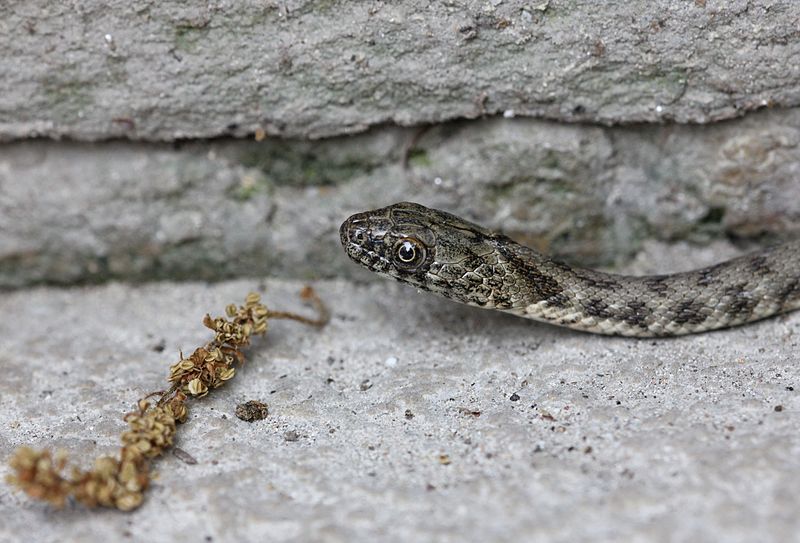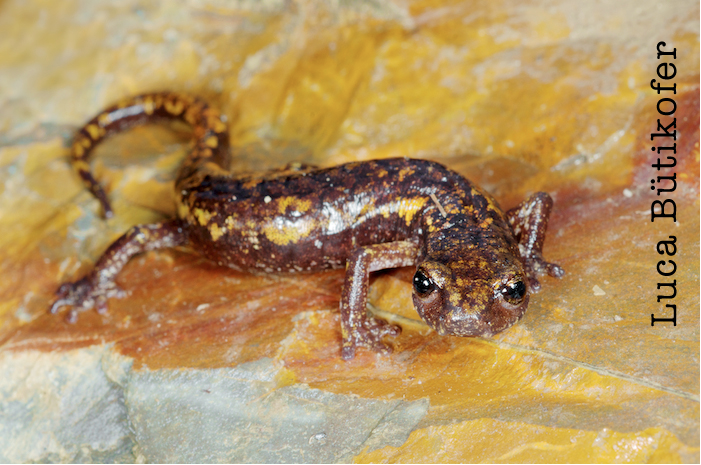What species does Speleomantes strinatii interact with?
Who are this species' predators?
 According to Askel Berg, a Soviet scientist, who raised specimens
of the Speleomantes strinatii from the surrounding area of
Genoa and specimens of Speleomantes
italicus in Florence, cave salamanders are eaten
by a number of snake species including grass snakes, (Natrix
natrix), (Salvidio
et al. 1992), dice snails (N. tessellate) and water
snails (N. maura). It should come as no surprise that
these snake species acquire S. strinatii as prey given that
all of these organisms tend to be most active at night. It is common to find
that small mammals and night birds living in the environments of the
North-west Italian Cave Salamander's habitat become threatened by predators (Lanza
et al. 2005).
According to Askel Berg, a Soviet scientist, who raised specimens
of the Speleomantes strinatii from the surrounding area of
Genoa and specimens of Speleomantes
italicus in Florence, cave salamanders are eaten
by a number of snake species including grass snakes, (Natrix
natrix), (Salvidio
et al. 1992), dice snails (N. tessellate) and water
snails (N. maura). It should come as no surprise that
these snake species acquire S. strinatii as prey given that
all of these organisms tend to be most active at night. It is common to find
that small mammals and night birds living in the environments of the
North-west Italian Cave Salamander's habitat become threatened by predators (Lanza
et al. 2005).
The organism, Natrix tessellata, is in the photo above.
The photo is from
Wikimedia Commons.
How does the Speleomantes strinatii defend against predators?
These salamanders vary in skin color (Encyclopedia of Life 2014). The base color of a salamander can range from light brown to black. The patterns/spots on these salamanders vary in abundance and location (Encyclopedia of Life 2014). As stated in the Habitat and Geography Page, these North-west Cave Salamanders most commonly live within cave habitats. It is hypothesized that the varying patterns of the salamanders skin have a direct correlation with the type of habitat they are living in. For example, a darker salamander with spots would blend in well with cave walls, making it difficult for predators to attack.
What does this organism like to eat?
 Speleomantes strinatii is an opportunistic predator that is able to seize
all invertebrates of the appropriate size (Salvidio et al.
1992). It is commonly found that S. strinatti prey on
individuals from the following taxonomic
groups:
Oligochaeta, Gastropoda Pulmonata Crustacea Isopoda, Araneae,
Pseudoscorpiones, Diptera, Coleoptera and Hymenoptera (Salvidio
et al. 1992). Although, there
are even more species in their diets (Salvidio et al. 1992).
Speleomantes strinatii is an opportunistic predator that is able to seize
all invertebrates of the appropriate size (Salvidio et al.
1992). It is commonly found that S. strinatti prey on
individuals from the following taxonomic
groups:
Oligochaeta, Gastropoda Pulmonata Crustacea Isopoda, Araneae,
Pseudoscorpiones, Diptera, Coleoptera and Hymenoptera (Salvidio
et al. 1992). Although, there
are even more species in their diets (Salvidio et al. 1992).
The photograph above was photographed by
Luca Bütikofer. This is a photograph of a
North-west Italian Cave Salamander.
Where does this species go to find food?
Adult salamanders have a broader and a more diversified trophic niche than juveniles (Salvidio et al. 1992). The analysis of food volume categories provides more informative data, showing that juveniles forage mostly on Isopoda. Data from 60 stomach contents showed that foraging occurred mainly on tunnel walls (Salvidio et al. 1992). This could be explained by considering the spatial segregation that constrains younger salamanders from living near the opening of the cavity and its immediate outside area, where they can prey on a more diversified invertebrate species like the adults (Salvidio et al. 1992).
Does Speleomantes strinatii have relationships with other organisms?
Yes! Parasites. Speleomantes strinatii is mainly parasitized by endoparasites, which is a parasite that lives in the organs and tissues of its host. It is believed that these parasites are responsible for noxious secretions on the salamander that aids in the digust of other organisms to its skin (Lanza et al. 2005). This is considered to be a mutualistic relationships between the two organisms. There is only one known ectoparasite, which is a parasite that lives on the external body of its host, living on these salamanders. They are of the genus Batracobdella algira (Lanza et al. 2005). This parasite does not benefit or harm the salamanders; therefore, this relationship is considered to be commensalism.
All I can say is that this organism has some friends and enemies.
The next page provides a plethora of interesting
facts about this species.
Return to Home Page.
